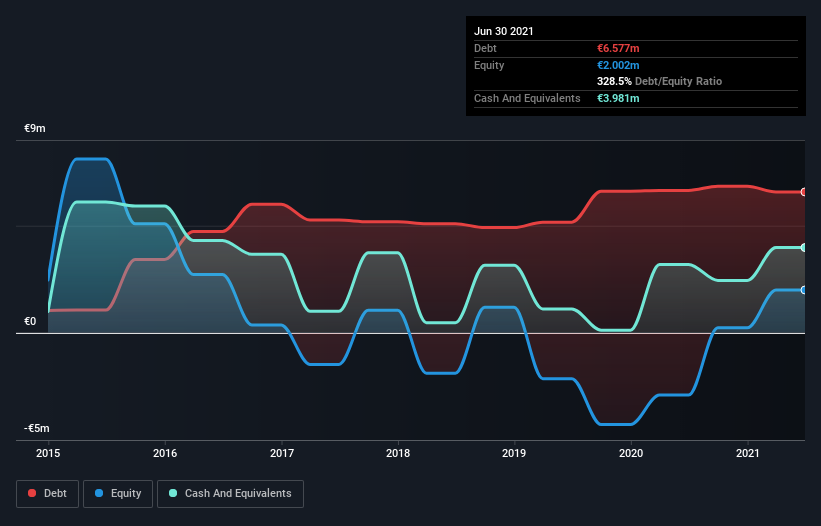
David Iben put it well when he said, 'Volatility is not a risk we care about. What we care about is avoiding the permanent loss of capital.' It's only natural to consider a company's balance sheet when you examine how risky it is, since debt is often involved when a business collapses. We note that Safe Orthopaedics SA (EPA:ALSAF) does have debt on its balance sheet. But should shareholders be worried about its use of debt?
Why Does Debt Bring Risk?
Debt and other liabilities become risky for a business when it cannot easily fulfill those obligations, either with free cash flow or by raising capital at an attractive price. If things get really bad, the lenders can take control of the business. However, a more frequent (but still costly) occurrence is where a company must issue shares at bargain-basement prices, permanently diluting shareholders, just to shore up its balance sheet. Of course, plenty of companies use debt to fund growth, without any negative consequences. When we examine debt levels, we first consider both cash and debt levels, together.
View our latest analysis for Safe Orthopaedics
What Is Safe Orthopaedics's Net Debt?
The chart below, which you can click on for greater detail, shows that Safe Orthopaedics had €6.58m in debt in June 2021; about the same as the year before. On the flip side, it has €3.98m in cash leading to net debt of about €2.60m.

How Healthy Is Safe Orthopaedics' Balance Sheet?
We can see from the most recent balance sheet that Safe Orthopaedics had liabilities of €6.00m falling due within a year, and liabilities of €8.00m due beyond that. On the other hand, it had cash of €3.98m and €2.63m worth of receivables due within a year. So its liabilities total €7.38m more than the combination of its cash and short-term receivables.
While this might seem like a lot, it is not so bad since Safe Orthopaedics has a market capitalization of €17.7m, and so it could probably strengthen its balance sheet by raising capital if it needed to. But we definitely want to keep our eyes open to indications that its debt is bringing too much risk. There's no doubt that we learn most about debt from the balance sheet. But ultimately the future profitability of the business will decide if Safe Orthopaedics can strengthen its balance sheet over time. So if you want to see what the professionals think, you might find this free report on analyst profit forecasts to be interesting.
Over 12 months, Safe Orthopaedics made a loss at the EBIT level, and saw its revenue drop to €4.0m, which is a fall of 7.8%. We would much prefer see growth.
Caveat Emptor
Importantly, Safe Orthopaedics had an earnings before interest and tax (EBIT) loss over the last year. Indeed, it lost a very considerable €7.5m at the EBIT level. When we look at that and recall the liabilities on its balance sheet, relative to cash, it seems unwise to us for the company to have any debt. Quite frankly we think the balance sheet is far from match-fit, although it could be improved with time. Another cause for caution is that is bled €7.7m in negative free cash flow over the last twelve months. So in short it's a really risky stock. The balance sheet is clearly the area to focus on when you are analysing debt. However, not all investment risk resides within the balance sheet - far from it. Case in point: We've spotted 6 warning signs for Safe Orthopaedics you should be aware of, and 3 of them are potentially serious.
If, after all that, you're more interested in a fast growing company with a rock-solid balance sheet, then check out our list of net cash growth stocks without delay.
New: Manage All Your Stock Portfolios in One Place
We've created the ultimate portfolio companion for stock investors, and it's free.
• Connect an unlimited number of Portfolios and see your total in one currency
• Be alerted to new Warning Signs or Risks via email or mobile
• Track the Fair Value of your stocks
This article by Simply Wall St is general in nature. We provide commentary based on historical data and analyst forecasts only using an unbiased methodology and our articles are not intended to be financial advice. It does not constitute a recommendation to buy or sell any stock, and does not take account of your objectives, or your financial situation. We aim to bring you long-term focused analysis driven by fundamental data. Note that our analysis may not factor in the latest price-sensitive company announcements or qualitative material. Simply Wall St has no position in any stocks mentioned.
Have feedback on this article? Concerned about the content? Get in touch with us directly. Alternatively, email editorial-team (at) simplywallst.com.
About ENXTPA:ALSAF
Safe Orthopaedics
A medical technology company, engages in the design, manufacturing, and marketing of sterile implants and single-use sterile surgical instruments for the treatment of spinal surgery.
Moderate and slightly overvalued.
Market Insights
Community Narratives



